
Chytolita is a monotypic litter moth genus of the family Erebidae erected by Augustus Radcliffe Grote in 1873. Its only species, Chytolita morbidalis, the morbid owlet moth or morbid owlet, was first described by Achille Guenée in 1854. It is found in large parts of North America, from coast to coast in the north and south to North Carolina, Texas and Florida in the west. The habitat consists of deciduous woods and edges.
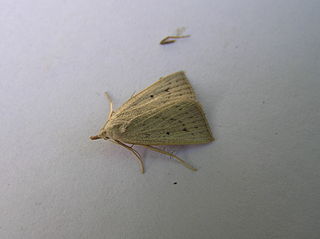
Macrochilo is a genus of litter moths of the family Erebidae. The genus was erected by Jacob Hübner in 1825.

Abagrotis alternata, the greater red dart or mottled gray cutworm, is a moth of the family Noctuidae. The species was first described by Augustus Radcliffe Grote in 1865. It is found in eastern North America, from New Brunswick west across southern Canada to western Alberta, south to Arizona, New Mexico and the Gulf of Mexico.
Abagrotis orbis, the well-marked cutworm or Barnes' climbing cutworm, is a moth of the family Noctuidae. The species was first described by Augustus Radcliffe Grote in 1876. It is in southwestern North America, extending eastward across the plains and with a large disjunct population in dune habitats in the southern Great Lakes area. It extends into western Canada only in the southern interior of British Columbia and southern Alberta and Saskatchewan.
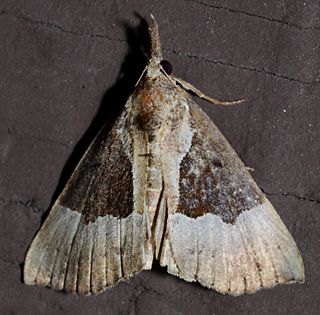
Hypena bijugalis, the dimorphic bomolocha, dimorphic hypena or toothed snout-moth, is a moth of the family Erebidae. The species was first described by Francis Walker in 1859. It is found in North America from Nova Scotia across southern Canada to Vancouver Island, south over the whole United States to Florida.
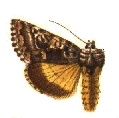
Syngrapha octoscripta, the figure-eight looper moth or dusky silver Y, is a moth of the family Noctuidae. The species was first described by Augustus Radcliffe Grote in 1874. It is found in North America from coast to coast in most of Canada south in the east to northern Pennsylvania, Ohio, and the Great Lakes states.

Protolampra brunneicollis, the brown-collared dart, is a moth of the family Noctuidae. The species was first described by Augustus Radcliffe Grote in 1864. It is found in eastern North America from New Brunswick to Alberta in southern Canada, and in the United States from Maine to North Carolina and Tennessee west to Mississippi, north to Minnesota, with scattered records in the west from North Dakota, South Dakota and Montana.
Xestia normaniana, or Norman's dart, is a moth of the family Noctuidae. The species was first described by Augustus Radcliffe Grote in 1874. It is found in North America from Nova Scotia across southern and central Canada to Alberta. In the eastern United States it ranges from Maine to eastern Minnesota, and south along the Appalachians to western North Carolina. It has recently been recorded from Tennessee.
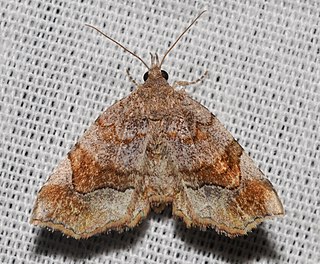
Pangrapta decoralis, the decorated owlet, is a moth in the family Erebidae. The species was first described by Jacob Hübner in 1818. It is found in North America from Alberta to Nova Scotia south to Florida and Texas.

Phalaenophana pyramusalis, the dark-banded owlet, is a moth of the family Erebidae. The species was first described by Francis Walker in 1859. It is found in North America from Saskatchewan to Nova Scotia, south to North Carolina and Texas.

Macrochilo orciferalis, the chocolate fan-foot or bronzy macrochilo, is a litter moth of the family Erebidae. The species was first described by Francis Walker in 1859. It is found in North America from Wisconsin to Nova Scotia, south to Florida and Texas.

Macrochilo litophora, the angulate fan-foot or brown-lined owlet moth, is a litter moth of the family Erebidae. The species was first described by Augustus Radcliffe Grote in 1873. It is found in the United States from Wisconsin, east to Massachusetts, south to North Carolina, South Carolina, Mississippi and Texas.

Macrochilo louisiana, the Louisiana macrochilo or Louisiana snout-moth, is a litter moth of the family Erebidae. The species was first described by William Trowbridge Merrifield Forbes in 1922. It is found in North America from Quebec and Maine to Florida, west to Texas, north to Alberta.

Phalaenostola larentioides, the black-banded owlet, is a moth of the family Erebidae. The species was first described by Augustus Radcliffe Grote in 1873. It is found in North America from New Brunswick and Wisconsin to Maine, south to Florida and Texas, west to Ontario.
Phalaenostola hanhami, also called Hanham's owlet or Hanham's snout moth, is a litter moth of the family Erebidae. The species was first described by J. B. Smith in 1899. It is found in North America from Nova Scotia, west across Canada to central Alberta, south to Massachusetts and New York.
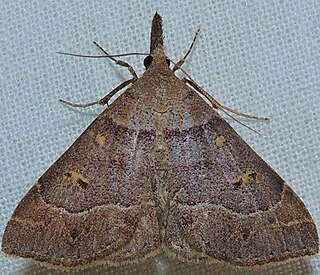
Renia flavipunctalis, the yellow-dotted renia, yellow-spotted renia or even-lined renia, is a litter moth of the family Erebidae. The species was first described by Carl Geyer in 1832. It is found from southern Canada to Florida and Texas.

Palthis angulalis, the dark-spotted palthis, is a moth of the family Erebidae. The species was first described by Jacob Hübner in 1796. It is found from Newfoundland west to coastal British Columbia, south to Florida and Texas.
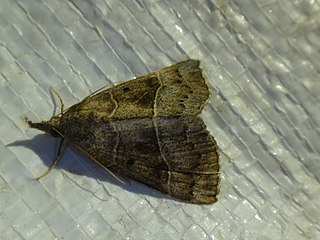
Hypena deceptalis, the deceptive hypena or deceptive bomolocha moth, is a moth of the family Erebidae. The species was first described by Francis Walker in 1859. It is found in North America from Manitoba to Quebec, south to Florida and Texas. It is absent from much of Gulf Coastal Plain though.
Spargaloma is a monotypic moth genus in the family Erebidae. Its only species is Spargaloma sexpunctata, the six-spotted gray. Both the genus and species were first described by Augustus Radcliffe Grote in 1873. It is found from coast to coast in lower Canada south in the east to Florida, Mississippi and Arkansas, in the west to California.

Trichordestra legitima, the striped garden caterpillar, is a moth of the family Noctuidae. The species was first described by Augustus Radcliffe Grote in 1864. It is found in eastern North America, from Newfoundland to Florida, west to Texas, north to Saskatchewan.















